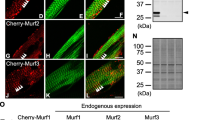Summary
Primary cultures of skeletal muscle cells secrete plasminogen activator (PA) activity to the conditioning medium and display membrane-bound PA. Growth of these cells in culture in presence of 10-7 M dexamethasone resulted in a marked reduction of the membranal and secreted PA activity. The hormone also reduced cytosolic creative phosphokinase (CPK) activity and cytosolic protein content. However, cell viability and their ability to undergo fusion were uneffected. The extent of hormone-induced reduction in PA activity depended on the time and extend of exposure. Maximal suppression was obtained by exposing the cells to dexamethasone during the first 4 days of culture. The medium conditioned with dexamethasone-treated cells did not inhibit plasmin, endogenous PA or exogenous PA. Exposure of the conditioned medium from hormone-treated cells to sodium dodecyl sulphate (SDS) or trypsin restored the activity to values observed in media from cells not exposed to the hormone. Acidification of the medium failed to reactivate the enzyme. The myogenic cell line L-8 also displayed membrane-bound PA activity, which was of a comparable magnitude in both fusing and non-fusing L-8 cells. However, in contrast to the primary cultures, exposure of L-8 cells to dexamethasone had no effect on their PA activity whether studied under conditions which allowed or prohibited fusion. The present findings imply that PA has no conducive role in the process of fusion associated with maturation of skeletal muscle cells.
Similar content being viewed by others
Abbreviations
- CPK:
-
Creative phosphokinase
- PA:
-
Plasminogen activator
- PBS:
-
Phosphate buffered saline
- SDS:
-
Sodium dodecyl sulphate
- TCA:
-
Trichloroacetic acid
References
Yaffe D: Rat skeletal muscle cells. In: Kruse PF, Patterson MK (eds) Tissue Culture Methods and Applications. Academic Press, New York, pp 106–114, 1973.
Bischoff R, Holtzer H: Mitosis and the processes of differentiation of myogenic cells in vitro. J Cell Biol 44:188–201, 1969.
Dym H, Turner DC, Eppenberger HM, Yaffe D: Creatine kinase isoenzyme transition in actinomycin D-treated differentiating muscle cultures. Exp Cell Res 113:15–21, 1978.
Sanwal BD: Myoblast differentiation. Trends Biochem Sci 4:155–157, 1979.
Lavie G, Yaffe D: Studies on the nature of the last cell division during the differentiation of rat skeletal muscle cells. In: Muller-Berat N et al. (ed) Progress in Differentiation Research. North-Holland Publishing Company, Amsterdam, pp 25–42, 1976.
Couch CB, Strittmatter WJ: Rat myoblast fusion requires metalloendoprotease activity. Cell 32:257–265, 1983.
Kaur H, Sanwal BD: Regulation of the activity of a calcium-activated neutral protease during differentiation of skeletal myoblasts. Can J Biochem 59:743–747, 1981.
Kirschke H, Wood L, Roisen FJ, Bird JWC: Activity of lysosomal cysteine proteinase during differentiation of rat skeletal muscle. Biochem J 214:871–877, 1983.
Miskin R, Easton TG, Reich E: Plasminogen activator in chick embryo muscle cells: Induction of enzyme by RSV, PMA and retinoic acid. Cell 15:1301–1312, 1978.
Festoff BW, Patterson MR, Romstedt K: Plasminogen activator: The major secreted neutral protease of cultured skeletal muscle cells. J Cell Physiol 110:190–195, 1982.
Christmas JK, Silverstein SC, Acs G: Plasminogen activators. In: Barrett AJ (ed) Proteinases in mammalian cells and tissues. North Holland Publishing Company, Amsterdam, pp 91–149, 1977.
Ossowski L, Beigel D, Reich E: Mammary plasminogen activator: Correlation with involution, hormonal modulation and comparison between normal and neoplastic tissue. Cell 16:929–940, 1979.
Isseroff R, Fusenig NE, Rifkin DB: Plasminogen activator in differentiating mouse keratinocytes. J Invest Dermatol 80:217–222, 1983.
Guerriero V, Florini JR: Dexamethasone effects on myoblast proliferation and differentiation. Endocrinology 106:1198–1202, 1980.
Mayer M, Chaouat M, Hadar R, Nissan S: Effect of dexamethasone and serum-deprivation on intracellular proteolysis in cultured muscle cells. J Cell Physiol 109:525–533, 1981.
Deutsch DG, Mertz ET: Plasminogen: Purification from human plasma by affinity chromatography. Science 170:1095–1096, 1970.
Scales D, Sabbadini R, Inesi G: The involvement of sarcotubular membranes in genetic muscular dystrophy. Biochem Biophys Acta 465:535–549, 1977.
Mayer M, Finci Z, Kanaany J, Kaiser N: Plasminogen activator and protease inhibitor activities in isolated rat thymocytes. Mol Cell Biochem 66:137–144, 1985.
Roth JS, Losty T, Wierbicki E: Assay of proteolytic enzyme activity using a 14C-labeled hemoglobin. Anal Biochem 42:214–221, 1971.
Mayer M, Neufeld B, Finci Z: Inhibition of serine proteases by steroids. Biochem Pharmacol 31:2989–2992, 1982.
Levin EG: Latent tissue plasminogen activator produced by human endothelial cells in culture: Evidence for an enzyme-inhibitor complex. Proc Natl Acad Sci USA 80:6804–6808, 1983.
Lowry DH, Rosebrough WJ, Farr AL, Randall RJ: Protein measurement with the Folin phenol reagent. J Biol Chem 193:265–275, 1951.
Schomberg M, Smith TJ, Krichevsky A, Bilezikian JP: Glucocorticoids enhance glucose uptake and affect differentiation and beta-adrenergic responsiveness in muscle cell cultures. Cell Differentiation 10:101–107, 1981.
Gelehrter TD, Barouski-Miller PA, Coleman PL, Cwikel BJ: Hormonal regulation of plasminogen activator in rat hepatoma cells. Molec Cell Biochem 53/54:11–21, 1983.
Crutchley DJ, Conanan LB, Maynard JR: Human fibroblasts produce inhibitor directed against plasminogen activator when treated with glucocorticoids. Ann NY Acad Sci 370:609–616, 1981.
Laug WE: Glucocorticoids inhibit plasminogen activator production by endothelial cells. Thromb Haemostas 50:888–892, 1983.
Coleman PL, Barouski PA, Gelehrter TD: The dexamethasone-induced inhibitor of fibrinolytic activity in hepatoma cells. A cellular product which specifically inhibits plasminogen activation. J Biol Chem 257:4250–4264, 1982.
Granelli-Piperno A, Reich E: A study of proteases and protease-inhibitor complexes in biological fluids. J Exp Med 148:223–234, 1978.
Scott RW, Eaton DL, Duran N, Baker JB: Regulation of extracellular plasminogen activator by human fibroblasts. The role of protease nexin. J Biol Chem 258:4397–4403, 1983.
Klocking HP, Jablonowski CH, Markwardt F: Studies on the release on plasminogen activator from the isolated rat lung by serine proteinases. Thromb Res 23:375–379, 1982.
Author information
Authors and Affiliations
Rights and permissions
About this article
Cite this article
Mayer, M., Finci, Z., Chaouat, M. et al. Plasminogen activator activity in differentiating rat myoblasts. Mol Cell Biochem 69, 147–154 (1986). https://doi.org/10.1007/BF00224761
Received:
Issue Date:
DOI: https://doi.org/10.1007/BF00224761




